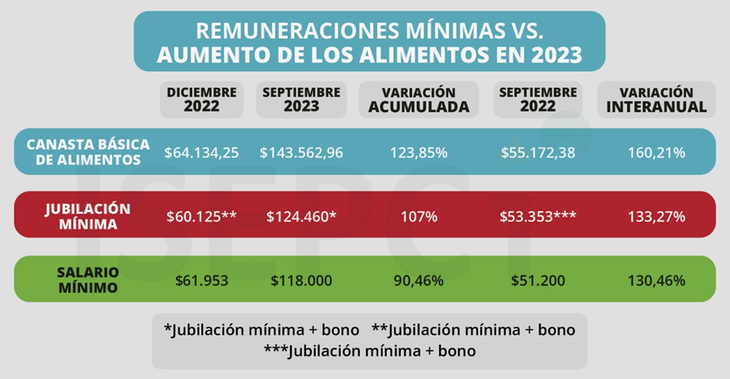The Basic Food Basket (CBA) in September rose 2.7%. This advance implies a strong deceleration inflationary after having reached August he highest increase in recent decadeswhen climbing a 27%.
The data arises from a survey carried out monthly by the Institute for Social, Economic and Citizen Policy Research (ISEPCI) and that involves eight hundred local businesses of the Popular neighbourhoods of twenty districts of the Buenos Aires suburbs.
The year-on-year increases and so far in 2023
As explained in the report, the deceleration of prices recorded in September is a respite but relative If you observe the evolution throughout 2023 and in the year-on-year comparison.
In September 2022 a family of two adults and two small children needed $55,172.38 to acquire your essential foods. While, twelve months laterlast September, the same products cost $143,562.96that is to say, 160.21% more.
And taking into account that December 2022 the value of the same CBA it was of $64,134.25he increase for the first nine months of 2023 it was of 123.85%.
increase 2023 CBA ISEPCI.png
In year-on-year termshe category that increased the most was that of Fruits and vegetables with 170%followed by the store with 160%and finally the meats that increased 154%.
Loss of purchasing power of retirees and employees
Isaac Rudnik is national director of the ISEPCI, affirms that if we compare these historic increases in food prices with the Minimum salaries and pensionsit becomes evident that a sharp loss of purchasing power of the latter.
The retired who charge the minimumin September 2023 they had compared to the same month of 2022 a increase of 133.27% . For their part, the workers who charge the minimum salary they perceived a increase of 130.46%.
While in the same period the value of the Basic Food Basket in nearby businesses in popular neighborhoods rose 160%.
Loss of purchasing power 2023 ISEPCI.png

Why does food go up?
The report states that, beyond the agreements with the IMF (which forced inflationary measures such as increased rates); the drought (which produced a drop in export income, which aggravated the traditional shortage of reserves); in the abrupt August 14 devaluation -also agreed with the IMF- price makers of the production and marketing chainsthey had –and have- a fundamental role in this entire process.
Rudnik explains that the prominence of the production and marketing chains is due to the fact that the measures of the ruling party for the reference pricing facility through programs such as careful, close, fair pricesand other similar ones, agreed directly with the owners of large food companies, were broken again and again.
Source: Ambito




